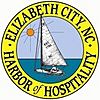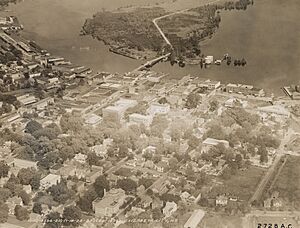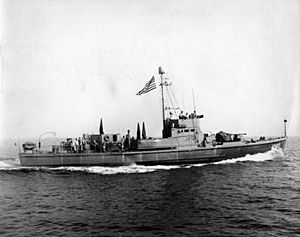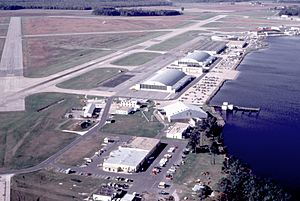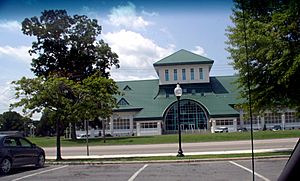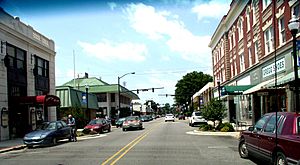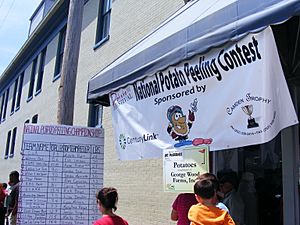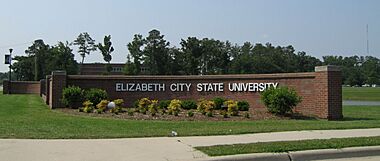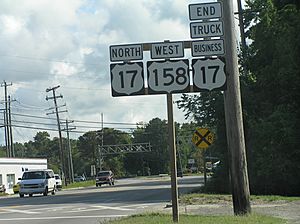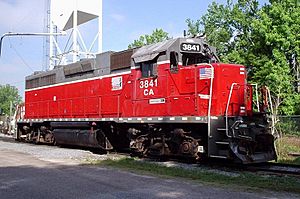Elizabeth City, North Carolina facts for kids
Quick facts for kids
Elizabeth City, North Carolina
|
|||
|---|---|---|---|
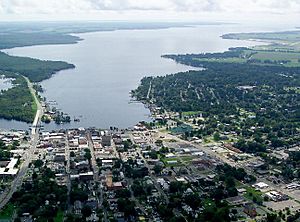
Elizabeth City facing the Pasquotank River
|
|||
|
|||
| Nickname(s):
Harbor of Hospitality, Best City in the 252, Betsy City, E.C., Queen of the Albemarle, River City
|
|||

Location in Pasquotank County in the state of North Carolina
|
|||
| Country | United States | ||
| State | North Carolina | ||
| Counties | Pasquotank | ||
| Area | |||
| • City | 11.71 sq mi (30.32 km2) | ||
| • Land | 11.71 sq mi (30.32 km2) | ||
| • Water | 0.00 sq mi (0.00 km2) | ||
| Elevation | 10 ft (3 m) | ||
| Population
(2020)
|
|||
| • City | 18,631 | ||
| • Density | 1,591.58/sq mi (614.50/km2) | ||
| • Metro | 63,270 | ||
| Time zone | UTC−5 (EST) | ||
| • Summer (DST) | UTC−4 (EDT) | ||
| ZIP codes |
27906, 27907, 27909
|
||
| Area code(s) | 252 | ||
| FIPS code | 37-20580 | ||
| GNIS feature ID | 2403551 | ||
Elizabeth City is a city in Pasquotank County, United States. In 2020, about 18,629 people lived there. It is the main city and county seat of Pasquotank County. Elizabeth City is important for culture, business, and education in the northeastern part of North Carolina.
It is often called the "Harbor of Hospitality." Elizabeth City has a long history of shipping. This is because it is located on a narrow bend of the Pasquotank River. The city was founded in 1794. It grew quickly thanks to the Dismal Swamp Canal, becoming a busy trading center. Today, Elizabeth City has a large United States Coast Guard base.
Contents
History of Elizabeth City
Elizabeth City is located where the Pasquotank River narrows. This spot was used for trading by early colonists. By the mid-1700s, there were inspection stations and ferries here. A small community grew with roads, a school, and a church.

In 1793, people started building the Dismal Swamp Canal. This canal was very important for Elizabeth City's trade. The town was first called "Redding" in 1793. In 1794, it was renamed "Elizabethtown." But there was another town with the same name. So, in 1801, the city was renamed "Elizabeth City." Some say the name "Elizabeth" came from Elizabeth "Betsy" Tooley. She owned a local tavern and gave land for the new town.
The Dismal Swamp Canal was improved, and trade boomed. Elizabeth City became a successful trading center in the early 1800s. In 1826, the government bought shares in the canal. More money was raised in 1829 to make the canal wider and deeper. This allowed bigger boats to use it.
In 1827, the US customs house moved to Elizabeth City. This helped the city's money grow even more. From 1829 to 1832, the fees for commercial shipping in Elizabeth City tripled.
During the American Civil War, the Confederate States had a small fleet here. After the Battle of Roanoke Island, Union forces took the city. Elizabeth City stayed under Union control for the rest of the war.
Over time, land travel improved. This allowed more trade with nearby areas. Ferries still connected Elizabeth City and Camden County. However, new canals and railroads nearby started to take some of the trade away. The Portsmouth and Roanoke Railroad, built in the 1830s, moved goods directly to Weldon. The Albemarle–Chesapeake Canal, finished in 1859, created a deeper path for ships.
Despite this, Elizabeth City became a busy deep-water port. It was a strong economic center. Industries like lumbering, shipbuilding, and fish processing thrived. It even competed with larger ports like Norfolk, Virginia. But in 1881, the Elizabeth City and Norfolk Railroad was built. This led industries to move to other growing cities in North Carolina.
World War II brought new life to Elizabeth City's industries. Shipbuilding, textiles, and aviation became very important. Coast Guard Air Station Elizabeth City opened in 1940. Navy Air Station Weeksville opened in 1941. These bases used seaplanes and dirigibles to watch for German U-boats. This helped protect American ships along the East Coast.
From 1942 to 1944, the Elizabeth City Shipyard built many ships for the war. It built thirty submarine chasers, four tugboats, and six quick supply boats. The shipyard built more subchasers than any other shipyard in the country. It also built them very quickly. The Elizabeth City Shipyard is still working today.
After the war, the economy changed. Elizabeth City's economy now focuses on services, government, and farming. Since the late 1990s, efforts to boost tourism and improve the downtown area have helped the economy.
Many historic places in Elizabeth City are on the National Register of Historic Places. These include the Elizabeth City Historic District and the Episcopal Cemetery. Protecting these sites helps bring visitors who want to learn about the city's unique past.
Geography and Climate
Elizabeth City is located along the Pasquotank River. This river connects to Albemarle Sound. Camden County is directly across the river.
The city covers about 11.71 square miles (30.32 km2). Most of this is land, with a small amount of water. Elizabeth City is in the "Inner Banks" area of North Carolina. It is mostly flat and marshy, only about 10 feet (3 meters) above sea level. Its location near the water has been key to its history. It once had busy oyster and timber industries.
Climate
Elizabeth City has a humid subtropical climate. This means it has mild changes in temperature and rain throughout the year. Being close to the Albemarle Sound and the Atlantic Ocean makes the temperatures less extreme. July usually has the highest temperatures and most rain. Thunderstorms are common in summer. Tropical storms and hurricanes can also happen because it's near the Atlantic Ocean. The city gets very little snow, usually about 0.2 inches (0.5 cm) each year.
| Climate data for Elizabeth City, North Carolina (1991–2020 normals, extremes 1911–2022) | |||||||||||||
|---|---|---|---|---|---|---|---|---|---|---|---|---|---|
| Month | Jan | Feb | Mar | Apr | May | Jun | Jul | Aug | Sep | Oct | Nov | Dec | Year |
| Record high °F (°C) | 80 (27) |
82 (28) |
92 (33) |
95 (35) |
101 (38) |
104 (40) |
107 (42) |
104 (40) |
99 (37) |
95 (35) |
90 (32) |
82 (28) |
107 (42) |
| Mean maximum °F (°C) | 71.9 (22.2) |
73.3 (22.9) |
80.0 (26.7) |
85.2 (29.6) |
90.9 (32.7) |
95.0 (35.0) |
96.1 (35.6) |
94.5 (34.7) |
90.8 (32.7) |
85.8 (29.9) |
78.7 (25.9) |
72.9 (22.7) |
97.3 (36.3) |
| Mean daily maximum °F (°C) | 53.2 (11.8) |
56.2 (13.4) |
63.2 (17.3) |
72.2 (22.3) |
78.9 (26.1) |
85.8 (29.9) |
88.9 (31.6) |
87.3 (30.7) |
82.2 (27.9) |
74.1 (23.4) |
64.0 (17.8) |
56.4 (13.6) |
71.9 (22.2) |
| Daily mean °F (°C) | 43.4 (6.3) |
45.4 (7.4) |
52.1 (11.2) |
61.3 (16.3) |
68.9 (20.5) |
77.1 (25.1) |
80.7 (27.1) |
79.1 (26.2) |
74.1 (23.4) |
64.4 (18.0) |
53.8 (12.1) |
47.0 (8.3) |
62.3 (16.8) |
| Mean daily minimum °F (°C) | 33.6 (0.9) |
34.7 (1.5) |
41.1 (5.1) |
50.4 (10.2) |
58.9 (14.9) |
68.4 (20.2) |
72.5 (22.5) |
70.9 (21.6) |
66.0 (18.9) |
54.7 (12.6) |
43.7 (6.5) |
37.6 (3.1) |
52.7 (11.5) |
| Mean minimum °F (°C) | 15.5 (−9.2) |
19.3 (−7.1) |
24.7 (−4.1) |
32.7 (0.4) |
42.6 (5.9) |
52.9 (11.6) |
61.8 (16.6) |
60.0 (15.6) |
51.8 (11.0) |
38.0 (3.3) |
27.2 (−2.7) |
21.8 (−5.7) |
13.1 (−10.5) |
| Record low °F (°C) | −2 (−19) |
5 (−15) |
11 (−12) |
17 (−8) |
22 (−6) |
39 (4) |
49 (9) |
47 (8) |
39 (4) |
24 (−4) |
17 (−8) |
−3 (−19) |
−3 (−19) |
| Average precipitation inches (mm) | 3.64 (92) |
3.29 (84) |
4.17 (106) |
3.47 (88) |
4.07 (103) |
4.49 (114) |
5.93 (151) |
5.91 (150) |
5.32 (135) |
3.70 (94) |
3.39 (86) |
3.88 (99) |
51.26 (1,302) |
| Average snowfall inches (cm) | 0.1 (0.25) |
0.1 (0.25) |
0.0 (0.0) |
0.0 (0.0) |
0.0 (0.0) |
0.0 (0.0) |
0.0 (0.0) |
0.0 (0.0) |
0.0 (0.0) |
0.0 (0.0) |
0.0 (0.0) |
0.0 (0.0) |
0.2 (0.51) |
| Average precipitation days (≥ 0.01 in) | 11.5 | 10.2 | 11.1 | 9.5 | 10.5 | 9.2 | 11.1 | 10.2 | 9.6 | 7.8 | 8.7 | 11.4 | 120.8 |
| Average snowy days (≥ 0.1 in) | 0.0 | 0.1 | 0.0 | 0.0 | 0.0 | 0.0 | 0.0 | 0.0 | 0.0 | 0.0 | 0.0 | 0.0 | 0.1 |
| Source: NOAA | |||||||||||||
| Climate data for Elizabeth City (Coast Guard Air Station Elizabeth City), North Carolina (1991–2020 normals, extremes 1948–present) | |||||||||||||
|---|---|---|---|---|---|---|---|---|---|---|---|---|---|
| Month | Jan | Feb | Mar | Apr | May | Jun | Jul | Aug | Sep | Oct | Nov | Dec | Year |
| Record high °F (°C) | 80 (27) |
85 (29) |
93 (34) |
92 (33) |
96 (36) |
101 (38) |
104 (40) |
103 (39) |
103 (39) |
96 (36) |
85 (29) |
81 (27) |
104 (40) |
| Mean maximum °F (°C) | 72.9 (22.7) |
74.4 (23.6) |
81.0 (27.2) |
85.8 (29.9) |
90.1 (32.3) |
94.9 (34.9) |
95.6 (35.3) |
94.4 (34.7) |
90.7 (32.6) |
86.5 (30.3) |
79.0 (26.1) |
73.9 (23.3) |
96.8 (36.0) |
| Mean daily maximum °F (°C) | 52.3 (11.3) |
55.0 (12.8) |
61.3 (16.3) |
70.8 (21.6) |
78.0 (25.6) |
85.4 (29.7) |
88.2 (31.2) |
86.8 (30.4) |
81.8 (27.7) |
73.4 (23.0) |
63.1 (17.3) |
55.6 (13.1) |
71.0 (21.7) |
| Daily mean °F (°C) | 42.7 (5.9) |
45.0 (7.2) |
50.9 (10.5) |
60.1 (15.6) |
68.2 (20.1) |
76.2 (24.6) |
79.6 (26.4) |
78.4 (25.8) |
73.4 (23.0) |
63.1 (17.3) |
52.7 (11.5) |
46.0 (7.8) |
61.4 (16.3) |
| Mean daily minimum °F (°C) | 33.1 (0.6) |
35.0 (1.7) |
40.5 (4.7) |
49.4 (9.7) |
58.4 (14.7) |
67.1 (19.5) |
71.0 (21.7) |
70.0 (21.1) |
64.9 (18.3) |
52.8 (11.6) |
42.4 (5.8) |
36.5 (2.5) |
51.8 (11.0) |
| Mean minimum °F (°C) | 16.1 (−8.8) |
21.0 (−6.1) |
25.7 (−3.5) |
33.8 (1.0) |
44.7 (7.1) |
54.5 (12.5) |
61.5 (16.4) |
60.0 (15.6) |
52.1 (11.2) |
36.9 (2.7) |
27.2 (−2.7) |
22.3 (−5.4) |
14.5 (−9.7) |
| Record low °F (°C) | 2 (−17) |
8 (−13) |
18 (−8) |
27 (−3) |
35 (2) |
45 (7) |
51 (11) |
49 (9) |
41 (5) |
26 (−3) |
19 (−7) |
9 (−13) |
2 (−17) |
| Average precipitation inches (mm) | 3.30 (84) |
2.87 (73) |
3.59 (91) |
3.16 (80) |
3.68 (93) |
4.71 (120) |
5.65 (144) |
5.32 (135) |
4.52 (115) |
3.63 (92) |
2.97 (75) |
3.11 (79) |
46.51 (1,181) |
| Average precipitation days (≥ 0.01 in) | 9.0 | 9.9 | 10.5 | 9.3 | 11.0 | 10.3 | 12.1 | 11.8 | 9.8 | 8.0 | 8.5 | 9.9 | 120.1 |
| Source: NOAA | |||||||||||||
- Notes
People in Elizabeth City
| Historical population | |||
|---|---|---|---|
| Census | Pop. | %± | |
| 1870 | 930 | — | |
| 1880 | 2,315 | 148.9% | |
| 1890 | 3,251 | 40.4% | |
| 1900 | 6,348 | 95.3% | |
| 1910 | 8,412 | 32.5% | |
| 1920 | 8,925 | 6.1% | |
| 1930 | 10,037 | 12.5% | |
| 1940 | 11,564 | 15.2% | |
| 1950 | 12,685 | 9.7% | |
| 1960 | 14,062 | 10.9% | |
| 1970 | 14,381 | 2.3% | |
| 1980 | 14,004 | −2.6% | |
| 1990 | 14,292 | 2.1% | |
| 2000 | 17,188 | 20.3% | |
| 2010 | 18,683 | 8.7% | |
| 2020 | 18,629 | −0.3% | |
| 2021 (est.) | 18,703 | 0.1% | |
| U.S. Decennial Census | |||
Population in 2020
| Race | Number | Percentage |
|---|---|---|
| White (not Hispanic) | 6,852 | 36.78% |
| Black or African American (not Hispanic) | 9,332 | 50.09% |
| Native American | 71 | 0.38% |
| Asian | 220 | 1.18% |
| Pacific Islander | 11 | 0.06% |
| Other/Mixed | 845 | 4.54% |
| Hispanic or Latino | 1,300 | 6.98% |
In 2020, Elizabeth City had 18,631 people. There were 6,526 households and 3,839 families living in the city.
Population in 2010
In 2010, there were 18,683 people in Elizabeth City. About 54% were African American and 39.5% were White. About 5% of the population was Hispanic or Latino.
There were 6,577 households. About 32.4% of these had children under 18. The average household had 2.42 people. The average family had 3.01 people.
The population was spread out by age. About 27.7% were under 19. About 13.9% were 65 or older. The average age was 31.3 years.
U.S. Coast Guard in Elizabeth City
The Coast Guard Air Station Elizabeth City was built in 1940. It is one of the largest United States Coast Guard Air Stations in the country. It covers over 800 acres. Six different Coast Guard groups are based here. These include the Air Station, Aviation Logistics Center, and Aviation Technical Training Center.
The base provides many jobs for the area. It also brings Coast Guard and industry workers from all over the country. The USCG Air Station was even featured in the 2006 Disney movie The Guardian.
Elizabeth City also has one of the few airship factories in the United States. Many commercial blimps are made and fixed here. These facilities used to be Naval Air Station Weeksville. This base operated from 1941 to 1957. Its airships were very important during World War II. They helped spot German U-boats. This helped protect ships along the East Coast.
One of the hangars at NAS Weeksville was the largest wooden building in the world. It was made of Southern Yellow Pine to save metal during the war. Sadly, it burned down in 1995.
There are plans for a joint airpark next to the Coast Guard base. This airpark aims to make Elizabeth City a major center for the aviation industry. It hopes to attract big companies and aviation programs from Elizabeth City State University.
Arts and Culture
Elizabeth City is home to the Museum of the Albemarle. This is a regional branch of the North Carolina Museum of History. The museum is near the city's waterfront. It has many exhibits about the history and culture of the Albemarle region. This area was settled by Europeans as early as 1668. This makes it one of the oldest settled areas in the country.
Downtown Elizabeth City also has Arts of the Albemarle. This is a group that supports arts in the region. It is located in "The Center," a renovated historic building. This building used to be a department store and an opera house. Now, it has three art galleries and the McGuire Theater for performances. The Center has helped boost the economy in downtown Elizabeth City.
The Virginia Dare Hotel and Arcade is a striking building in Elizabeth City. It has been a major part of the city's skyline since 1927. It was designed by William Lee Stoddart, a famous hotel architect. The nine-story building was called the Albemarle's first "skyscraper." It is still the tallest building in the region.
The hotel had 100 rooms. It also had a heated garage. For over 40 years, it was the main hotel and social center in Elizabeth City. Today, it is an apartment complex for older adults.
Elizabeth City has been the birthplace of some important people. Judge John Warren Davis was born here. He was a federal judge. John C. B. Ehringhaus was also born here. He was the governor of North Carolina from 1933 to 1937. A major street, Ehringhaus Street, is named after him.
Famous nine-ball player Luther Lassiter was born in Elizabeth City. He learned many of his pool skills at the City Billiards pool hall.
In 1929, the American Moth Boat was invented in Elizabeth City. This is a type of recreational sailboat. The city holds a Moth Boat Regatta every year in late February. The Moth Boat is even shown on the city's seal.
North Carolina Potato Festival
Elizabeth City hosts the North Carolina Potato Festival every year. This festival celebrates the potato, which is an important crop in the region. The festival is very popular. It usually takes place in mid-May in downtown Elizabeth City.
Albemarle Craftsman's Fair
This fair happens every Christmas. It is sponsored by the Albemarle Craftsman's Guild. Artisans, many in old-fashioned costumes, sell and show traditional crafts. These crafts include quilting, pottery, jewelry, and woodwork.
Juneteenth Celebration
This yearly event celebrates the freeing of African slaves in America. It is sponsored by River City Community Development Corporation. It has become a celebration for people of all backgrounds. The festival features vendors, information booths, speakers, entertainment, and food.
Media
The Daily Advance has been Elizabeth City's only daily newspaper since 1911.
Elizabeth City is part of the Hampton Roads television market. Most TV stations in the area come from southeastern Virginia. These include WTKR (CBS), WAVY (NBC), WVEC (ABC), WVBT (FOX), and WHRO (PBS).
Some local stations include WUND (PBS) and WSKY (independent). There is also W18BB-D, which broadcasts from Elizabeth City State University.
Education
All public schools in Elizabeth City are managed by the Elizabeth City-Pasquotank County School Board. This system is called Elizabeth City-Pasquotank Public Schools (ECPPS). It has seven elementary schools, two middle schools, two high schools, and other special programs.
Elementary Schools
- Central Elementary
- J.C. Sawyer Elementary
- Northside Elementary
- Pasquotank Elementary
- P.W. Moore Elementary
- Sheep-Harney Elementary
- Weeksville Elementary
Middle Schools
- Elizabeth City Middle
- River Road Middle
High Schools
- Northeastern High
- Pasquotank County High
- Elizabeth City-Pasquotank Early College
Alternative School
- H.L. Trigg Alternative
Public Charter STEM School
- Northeast Academy for Aerospace and Advanced Technologies (NEAAAT)
Private Schools
- Albemarle School
- Cathedral Christian Academy
- Foreshadow Academy
- Grace Montessori Academy
- New Life Academy
- Victory Christian School
Colleges and Universities
Elizabeth City has one private and two public colleges.
Elizabeth City State University (ECSU) is part of the University of North Carolina System. It is a historically African-American school. About 2,930 students attended in fall 2011. It offers many different degrees.
ECSU has Aviation Science programs at the Elizabeth City Regional Airport. It also has a Doctor of Pharmacy program with the University of North Carolina at Chapel Hill.
The main campus of the College of the Albemarle (COA) is also here. It was the first community college created under North Carolina's Community College Act of 1960. COA has other campuses in nearby towns.
Mid-Atlantic Christian University is a private Christian school. It was founded in 1948. It is located along the Pasquotank River.
All three schools have agreements. This allows students to take classes at more than one school.
Healthcare
The main hospital in Elizabeth City is Sentara Albemarle Medical Center. It is a 182-bed hospital. It is part of the Sentara Healthcare system. The hospital has been open since 1914. It moved to its current location in 1960.
In 2014, Sentara Healthcare took over managing the hospital. Sentara promised to improve patient care. They also planned to invest a lot of money in the hospital building.
City Services and Utilities
Elizabeth City has its own police (ECPD) and fire (ECFD) departments. It also has departments for public housing, water, sewer, and electricity. The city works with Pasquotank County on parks, recreation, and social services. They also run the Witherspoon Memorial Library.
Elizabeth City buys electricity from Dominion North Carolina Power. This electricity comes from natural gas and nuclear power plants in nearby Virginia.
Electricity is also made locally by solar and wind farms in Pasquotank County. These include Dominion Energy's Morgan's Corner solar farm and Avangrid Renewables' Amazon Wind Farm East.
Local phone service is provided by CenturyLink. Cable TV and Internet are provided by Time Warner. Natural gas is provided by Piedmont Natural Gas.
Transportation
Highways
Elizabeth City is connected to other areas by many highways.
It is unusual because four different branches of U.S. Route 17 pass through the city. Most communities only have two or three.
Mainline ![]() US 17 enters Pasquotank County from the southwest. Bypass US 17 splits off to the northwest. Mainline US 17 continues into Elizabeth City as Hughes Boulevard.
US 17 enters Pasquotank County from the southwest. Bypass US 17 splits off to the northwest. Mainline US 17 continues into Elizabeth City as Hughes Boulevard.
![]()
![]() US 17 Bus. (since 1969) goes east as Ehringhaus Street. This street is named after Governor John C. B. Ehringhaus. The route then turns north through Downtown as North Road Street.
US 17 Bus. (since 1969) goes east as Ehringhaus Street. This street is named after Governor John C. B. Ehringhaus. The route then turns north through Downtown as North Road Street.
Invalid type: US-Bus-Truck is a special route for trucks. It travels from the Camden Causeway west along Elizabeth Street. Then it goes north along Hughes Boulevard.
![]()
![]() US 17 Byp. (since 2002) is a modern freeway. It was finished in 2002. This bypass goes around the west side of the city for 9.3 miles (14.9 km). It helps traffic flow better. This bypass is an important part of the future I-87.
US 17 Byp. (since 2002) is a modern freeway. It was finished in 2002. This bypass goes around the west side of the city for 9.3 miles (14.9 km). It helps traffic flow better. This bypass is an important part of the future I-87.
![]() US 158 enters Elizabeth City from the east. This includes areas like the Outer Banks. It travels west through town as Elizabeth Street. It temporarily joins US 17 along Hughes Boulevard.
US 158 enters Elizabeth City from the east. This includes areas like the Outer Banks. It travels west through town as Elizabeth Street. It temporarily joins US 17 along Hughes Boulevard.
![]() NC 344 connects the US 17 Bypass to southern Pasquotank County. NC 344 is an important road for businesses and industries. It provides access to Coast Guard Air Station Elizabeth City and Elizabeth City State University.
NC 344 connects the US 17 Bypass to southern Pasquotank County. NC 344 is an important road for businesses and industries. It provides access to Coast Guard Air Station Elizabeth City and Elizabeth City State University.
Future Plans
I-87 is planned to connect Elizabeth City to the Interstate Highway System. When finished, it will run from Raleigh to Norfolk, Virginia. It will use parts of US 64, US 13, and US 17, upgrading them to Interstate standards.
Air Travel
Elizabeth City has a joint civil-military airport. It is shared with the U.S. Coast Guard Air Station Elizabeth City. The airport is called Elizabeth City Regional Airport (ECG). It is about 4 miles (6.4 km) southeast of the city.
For regular flights, people use Norfolk International Airport (ORF). This airport is about an hour north in Norfolk, Virginia.
Bus Travel
Local bus service is provided by the Inter-County Public Transportation Authority. It serves Pasquotank and nearby counties.
Elizabeth City also has regular bus service through Greyhound.
Rail Travel
The Chesapeake and Albemarle Railroad is a short rail line. It runs for 82 miles (132 km) between Edenton, North Carolina, and Chesapeake, Virginia. This line was first built in 1881. It was once a main line for the Norfolk Southern Railway. But as industries changed, the line became less important. Today, it mostly carries grain, sand, and gravel.
Passenger train service to Elizabeth City ended in 1947. The closest passenger train service is now in Newport News, Virginia. This is about an hour north.
Famous People from Elizabeth City
Academics
- Joseph C. Price (1854–1893), founder and first president of Livingstone College
- Lorenzo Dow Turner (1890–1972), a linguist who studied the Gullah language
Business
- James W. Owens (born 1946), former head of Caterpillar Inc.
Sports
- Luther "Wimpy" Lassiter (1918–1988), a world-famous nine-ball pool player
- Cecil Rouson (born 1962), former NFL running back for the New York Giants
- Sha'Keela Saunders (born 1993), a track and field athlete who competes in the long jump
- Anthony Smith (born 1967), former NFL defensive end
- John Walton (born 1947), former NFL quarterback
- Kenny Williams (born 1969), former professional basketball player
Entertainment
- Max Roach (1924–2007), a nationally known jazz drummer and composer. He was born near Elizabeth City.
- Scott Sanders (born 1968), a screenwriter and director
Other Notable People
- Franklin D. Miller (1945–2000), a United States Army staff sergeant and Medal of Honor recipient
- Edward Snowden (born 1983), known for sharing classified government documents in 2013
See also
 In Spanish: Elizabeth City para niños
In Spanish: Elizabeth City para niños



